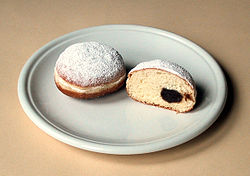Krapfen (doughnut): Difference between revisions
No edit summary |
polish, hebrew |
||
| Line 9: | Line 9: | ||
== See also == |
== See also == |
||
* [[John F. Kennedy]]'s 1963 remark "[[Ich bin ein Berliner]]". |
* [[John F. Kennedy]]'s 1963 remark "[[Ich bin ein Berliner]]". |
||
* [[Pączki]] |
|||
* [[Sufganiyah]] |
|||
{{Spoken Wikipedia|Berliner (pastry).ogg|2005-04-17}} |
{{Spoken Wikipedia|Berliner (pastry).ogg|2005-04-17}} |
||
Revision as of 10:04, 14 December 2005

A Berliner is a predominantly German pastry made from sweet yeast dough baked in fat, which has a marmalade or jam filling and usually icing, powdered sugar or conventional sugar on top. They are also sometimes available with a chocolate, champagne, mocha, advocaat or no filling at all. The filling is injected using a large syringe after baking. In English-speaking countries Berliner are usually known as doughnuts and are usually filled with jam.
The terminology used to refer to this pastry differs in various areas of Germany. While most areas call it Berliner, residents of Berlin, Brandenburg and Saxony call them Pfannkuchen, which in the rest of Germany generally refers to pancakes. Parts of Southern Germany and Austria call them Krapfen or in Palatinate Fastnachtsküchelchen, other areas of Austria refers to crullers; in Italy is called (maybe erroneously) Krafen.
Berliners are traditionally eaten to celebrate on New Year's Eve (Silvester) as well as the carnival holidays (Shrove Tuesday). A common practical joke has some Berliners being filled with mustard in place of jam in such a way that they can not be distinguished from the outside.
See also
- John F. Kennedy's 1963 remark "Ich bin ein Berliner".
- Pączki
- Sufganiyah
